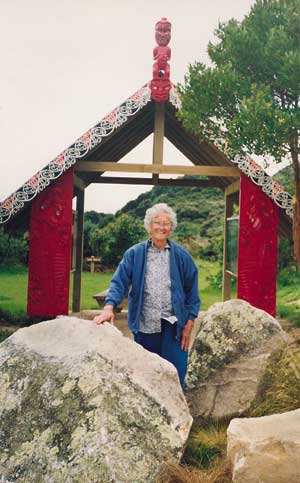

| "> |
Maori History
It is difficult to date accurately the arrival of Maori in GOLDEN BAY (or Mohua, to give the district its old Maori name) but is likely to have been from the earliest times. Some of the place names and legends of GOLDEN BAY are ancient, and derive from the Hawaikian Polynesian roots of the ancestral Maori. For example the names Takaka and Motueka have probably persisted for centuries as place names in the district; Ta'a'a and Motue'a are a few miles apart on the island of Raiatea in the Tahitian group, believed to be the Hawaiki of several of the "Fleet Canoes" of the Maori migrations. A legend about a taniwha (monster) called Kaiwhakaruaki which was once the scourge of Parapara Inlet, has local variants in several other districts of New Zealand, and is found throughout Polynesia. GOLDEN BAY was always important as a resource area in its own right and as a supply route to and from important resources to the south. Near Puponga quartzite was quarried for knives and from Parapara valuable red and black pigments for dyeing were mined. The resources to the south included kakara taramea (Karamea) - a rare and valuable aromatic~ herb, sandstone abrasives for stone-working, a very hard flint for drilling other stone, and the prized pounamu (greenstone) of Te Tai Poutini (Westland). Whoever controlled the Bay, controlled one of the major routes to and from these important resources. Archaeological evidence reveals the importance of moa and other extinct species for food and implements. Signs of Maori habitation can still be discerned on almost every headland and promontory through the Bay from Separation Point to Puponga and down the western coastline. Evidence of seasonal habitation, possibly for fishing, harvesting or cropping, also abounds - in bays, inlets, on rivers and streams. Literally thousands of artifacts have been found in most districts throughout the Bay. Many inland sites were frequented and several routes through the hinterland were well known; the proliferation of Maori names throughout the region attests to their familiararity with these places. It was at the hands of Tumatakokiri, the tribe which was in occupation at the time, that four of Abel Tasman's men met their death. Several theories have been advanced to explain this tragedy - that Tasman's men had unwittingly rowed into waters which were tapu (sacred) or had had a rahui (ban) placed on them; - that these strange white men in strange ships with strange ways (dress, muskets etc.) were taniwha who had to be chased away. Unfortunately the eventual misfortunes of Tumatakokiri have blurred their history to the extent that it can only be speculated about the possible participants in the events of 1642 and their reasons for them. Despite having collected a number of Tumatakokiri whakapapa (family trees), we cannot identify with any confidence the resident chiefs of families who might have occupied Taupo Pa or neighbouring villages at Whariwharangi Bay or Wainui at the time of Tasman's visit. The 1827-1828 conquest, by Te Rauparaha and sub tribes, was the final Maori invasion/occupation; European settlement and the Treaty of Waitangi brought a cessation of traditional inter-tribal hostilities. The present-day tangata whenua families are descendants of the occupying Ngati Rarua, Ngati Tama and Te Atiawa with whom the New Zealand Company and the Crown had dealings in the early 1840's. At that time, the Maori population of GOLDEN BAY was variously estimated at up to several hundred people, with wide seasonal fluctuations according to labour requirements for harvesting, cropping, fishing, etc. However, over the decades following colonisation, many left. Since then only a few Maori families have "kept warm the hearths of their ancestors' papakainga" in the Bay, although a recent reunion of the descendants of one 1820's couple, Henare Te Keha and Wiki Te Amohou, brought over 200 people to visit the ancestral graves, pa, village and home sites in the district. While retaining fierce pride in their Maori heritage, most Maori of the Bay share European ancestry and today stand tall in both cultures of New Zealand society. Continue to read information about >>>> The Treasured Pathway Golden Bay businesses, get
listed with the Golden Bay Directory, its simple and FREE!
|
||||
Home | User
Contributions | Visitors Guide | Golden
Bay Directory
Contact gbnet | Search
the Net | gbnet Webmail
Advertising and sponsorship opportunities
© 2002 gbnet

